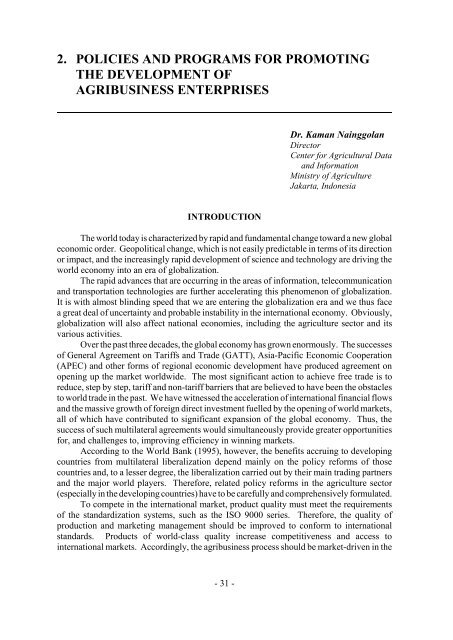Development of Agribusiness Enterprises - Asian Productivity ...
Development of Agribusiness Enterprises - Asian Productivity ...
Development of Agribusiness Enterprises - Asian Productivity ...
Create successful ePaper yourself
Turn your PDF publications into a flip-book with our unique Google optimized e-Paper software.
2. POLICIES AND PROGRAMS FOR PROMOTING<br />
THE DEVELOPMENT OF<br />
AGRIBUSINESS ENTERPRISES<br />
INTRODUCTION<br />
- 31 -<br />
Dr. Kaman Nainggolan<br />
Director<br />
Center for Agricultural Data<br />
and Information<br />
Ministry <strong>of</strong> Agriculture<br />
Jakarta, Indonesia<br />
The world today is characterized by rapid and fundamental change toward a new global<br />
economic order. Geopolitical change, which is not easily predictable in terms <strong>of</strong> its direction<br />
or impact, and the increasingly rapid development <strong>of</strong> science and technology are driving the<br />
world economy into an era <strong>of</strong> globalization.<br />
The rapid advances that are occurring in the areas <strong>of</strong> information, telecommunication<br />
and transportation technologies are further accelerating this phenomenon <strong>of</strong> globalization.<br />
It is with almost blinding speed that we are entering the globalization era and we thus face<br />
a great deal <strong>of</strong> uncertainty and probable instability in the international economy. Obviously,<br />
globalization will also affect national economies, including the agriculture sector and its<br />
various activities.<br />
Over the past three decades, the global economy has grown enormously. The successes<br />
<strong>of</strong> General Agreement on Tariffs and Trade (GATT), Asia-Pacific Economic Cooperation<br />
(APEC) and other forms <strong>of</strong> regional economic development have produced agreement on<br />
opening up the market worldwide. The most significant action to achieve free trade is to<br />
reduce, step by step, tariff and non-tariff barriers that are believed to have been the obstacles<br />
to world trade in the past. We have witnessed the acceleration <strong>of</strong> international financial flows<br />
and the massive growth <strong>of</strong> foreign direct investment fuelled by the opening <strong>of</strong> world markets,<br />
all <strong>of</strong> which have contributed to significant expansion <strong>of</strong> the global economy. Thus, the<br />
success <strong>of</strong> such multilateral agreements would simultaneously provide greater opportunities<br />
for, and challenges to, improving efficiency in winning markets.<br />
According to the World Bank (1995), however, the benefits accruing to developing<br />
countries from multilateral liberalization depend mainly on the policy reforms <strong>of</strong> those<br />
countries and, to a lesser degree, the liberalization carried out by their main trading partners<br />
and the major world players. Therefore, related policy reforms in the agriculture sector<br />
(especially in the developing countries) have to be carefully and comprehensively formulated.<br />
To compete in the international market, product quality must meet the requirements<br />
<strong>of</strong> the standardization systems, such as the ISO 9000 series. Therefore, the quality <strong>of</strong><br />
production and marketing management should be improved to conform to international<br />
standards. Products <strong>of</strong> world-class quality increase competitiveness and access to<br />
international markets. Accordingly, the agribusiness process should be market-driven in the
















